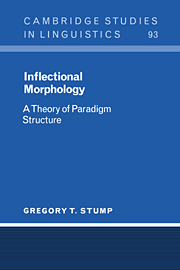2 - Paradigm functions
Published online by Cambridge University Press: 14 October 2009
Summary
In this chapter, I present the fundamental principles and claims underlying Paradigm Function Morphology; in particular, I elucidate the notion ‘paradigm function’ and its centrality to the organization of a language's inflectional morphology. A detailed exploration of the evidence motivating the properties of Paradigm Function Morphology is undertaken in chapters 3 to 8; the present chapter is concerned less with justifying these properties than simply with making them as explicit as possible.
After a preliminary discussion of the foundational ideas upon which Paradigm Function Morphology rests (section 2.1), I proceed to a detailed formal account of the architecture of the theory. In this discussion, it is useful to have a rich inflectional system to draw upon as an exemplificatory frame of reference; in order to make the principles and claims of Paradigm Function Morphology maximally explicit, I will demonstrate their implications for the analysis of an extensive fragment of Bulgarian verb morphology. Accordingly, an informal overview of this system is presented in section 2.2; the range of linguistically significant generalizations pertinent to this system favours the postulation of a richly differentiated inventory of rule types. I examine the nature of morphosyntactic properties (section 2.3) and their relationship to the notions of paradigm and paradigm function (section 2.4); the nature of realization rules and their organization into ‘blocks’ (section 2.5); the role of morphophonological rules in the evaluation of realization rules (section 2.6); and the role of realization rules in the definition of a language's paradigm function (section 2.7).
- Type
- Chapter
- Information
- Inflectional MorphologyA Theory of Paradigm Structure, pp. 31 - 61Publisher: Cambridge University PressPrint publication year: 2001



